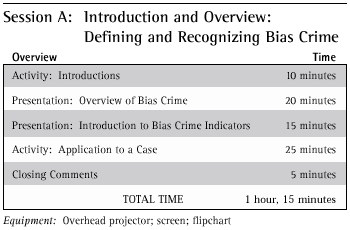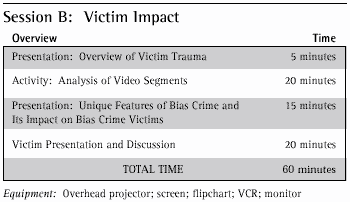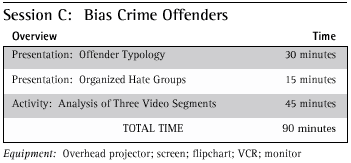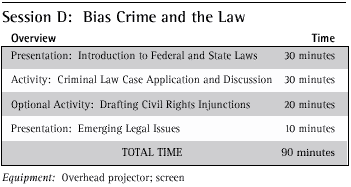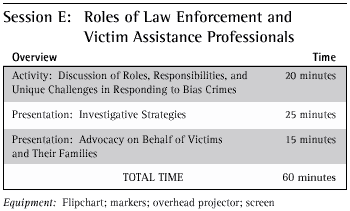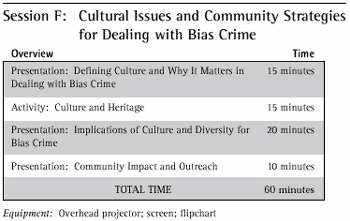Guide to Using This Curriculum
Bias crimes seriously threaten our democratic society, which is built on the strength of its diversity. These crimes represent a particularly heinous form of violence, in which thousands of Americans are victimized each year because of their skin color, ethnicity, religion, gender, sexual orientation, or disability. Growing concern exists around the country, in communities large and small, urban, suburban, and rural, about the prevalence of bias crime. Swift and effective investigation, prosecution, and response to these crimes is critical for developing and maintaining both respect for and appreciation of the growing diversity of our country's citizens.
This training package builds on the best efforts and practices to date, identified by national experts in law enforcement, victim assistance, and hate crime prevention and response. This curriculum differs from others in that it is intended for a multidisciplinary training audience, including law enforcement officers, victim advocates, and community-based organizations. It was field-tested to ensure its relevance to both victim assistance and law enforcement professionals and its user-friendliness. The results are reflected in the approach and materials presented here in this curriculum.
Professionals in the fields of both law enforcement and victim assistance feel a growing desire to better respond to victims of bias crime and to work together more effectively. With the increased national awareness of the need to recognize and respond to these crimes, and with the growing number of states enacting hate crime legislation, professionals in these fields express a need for up-to-date training that is multidisciplinary in nature.
Responding to Hate Crime: A Multidisciplinary Curriculum was developed to meet this need. Its focus is capacity building, and its purpose is to strengthen the knowledge and skills of individual professionals in law enforcement and victim assistance. Specifically, it is designed to do the following:
-
Provide law enforcement officials with up-to-date information and strategies to use in identifying bias crimes and in taking appropriate actions to deter and investigate these crimes
-
Provide victim assistance professionals with up-to-date information and strategies to use in assisting bias crime victims
-
Strengthen the capacity of professionals in both fields to contribute to successful investigation and prosecution of bias crime, and contribute to changing the community norms that presently foster a tolerance to and indifference towards these crimes
-
Provide professionals in both fields with the perspectives and strategies to work more effectively within their own departments and agencies, with one another, and within their communities
Key Features of the Training Approach
Responding to Hate Crime: A Multidisciplinary Curriculum is a six-session training program. Several characteristics central to its design are important to understand.
Integrated Audience
The curriculum is designed for an integrated audience of law enforcement and victim assistance professionals. Since a major training goal is to provide a forum where professionals from these two fields can learn from one another, most of the sessions are structured either for the entire audience, or smaller integrated groups of representatives from each field. The pilot test showed that a major benefit for participants is the chance to interact and learn, side by side, with professionals from their own and one another's fields.
Comprehensive Approach
This curriculum was developed to address the range of issues relevant to bias crime: deterrence and prevention, the needs of victims and the community, and the ability of the criminal justice system to investigate, report, and prosecute these crimes. It was also developed in a modular format to enable local jurisdictions to adapt and customize their own trainings based on their particular needs and time constraints.
Interactive Style
The curriculum is designed to take into account the characteristics of adult learners. Participants respond best and learn most in a forum that fosters discussion and interactive learning. Therefore, the training is designed to promote discussion and interaction. Activities have been developed and selected to provide the greatest opportunities for skill building in the most comfortable manner.
Law enforcement and victim assistance professionals collectively bring a broad base of knowledge and experience to the training. Several activities in this curriculum provide an opportunity for law enforcement and victim assistance professionals to solve problems together.
Case Studies
The cases used in this curriculum are adapted from actual criminal cases gathered from police departments and prosecutor's offices. Names and addresses have been changed to preserve anonymity. Cases were specially selected to illustrate various aspects of bias crime and provide authenticity to enhance group discussions. In adapting this curriculum for local use, instructors may change the type of victimization, locales, and/or names used in the cases to reflect their regions.
Organization of the Curriculum
Each session is organized as follows:
- Overview: Shows, at a glance,
the content, method, and suggested time allotted to each part of the
session
- Objectives: Details the anticipated
learning outcomes of each session
- Time: Specifies the amount of time
required for the session
- Videos: Lists videos to be obtained
and previewed before leading the session, where applicable
- Notes to the Instructor: Highlights
important points that instructors should make, and provides special
instructions for implementing each session or activity
- Instructor's Notes: Presents the
content for the session, describes the methodology (e.g., presentation,
activity, case discussion), and includes a discussion framework and
key questions, directions for conducting activities, and any other background
information that will be useful to instructors as they conduct the training
or review key topics
- Transparencies and Handouts: Presents in each session hard copy pages, marked and coded, that can be copied onto overhead transparency sheets or for distribution as handouts; often, a more expanded version of a transparency's text will appear in the Instructor's Notes
To assist instructors, the curriculum uses a series of icons to show when videos, transparencies, handouts, case studies, and flipcharts will be used during the course of each session. These icons are as follows:
|
|
Flipchart
|
|
Videotape
|
|
|
Transparency
|
|
Handout
|
|
|
Case Study
|
|
Preparations for Sponsoring and Conducting the Training
Cosponsoring the Training
It is recommended that this training be jointly sponsored by a law enforcement agency and victim service agency.
Recruitment of Instructors
Instructors for the training can be recruited from any of the following organizations:
- Local police department, sheriff's department,
or other law enforcement agency
- Federal Bureau of Investigation
- Community Relations Service of the Department
of Justice
- United States Attorney's office
- State Attorney General's office
- County Prosecuting Attorney's office
- Legal advocacy organizations
- National victim organizations
- State victim assistance agencies
- Victim advocacy organizations
- Mental health organizations
- Universities with programs in criminal
justice
- Community-based/civil rights organizations
Instructors should have the following background:
- Diversity training
- Awareness and understanding of the impact
of bias crime and the need for effective responses
- Experience in conducting training with law enforcement and/or victim assistance professionals
Instructors should also be representative of the community and should be diverse in terms of cultural background, gender, and professional affiliation.
Recruitment of Participants
Participants from law enforcement and victim services may be recruited from the same list of agencies and departments utilized for recruiting instructors. Participants should be balanced in terms of:
- cultural background and gender
- professional affiliation
- level of experience
Planning for Individual Sessions
Planning for Session B: Victim Impact
This session incorporates a presentation from an actual victim of a bias crime. The purpose of the presentation is as follows:
- To demonstrate the impact of a bias
crime on the victim
- To make the trauma experienced by the
victim real to participants
- To reinforce the fact that bias crimes occur within the local community
The instructor may be able to recruit a victim from the following agencies or departments:
- Police department
- Prosecutor's office
- Victim service agency
- Advocacy organization
The following are important issues to address before recruiting a victim:
- Victim's need for confidentiality and/or
privacy
- Status of the victim's case in court
- Time frame of the victim's trauma (i.e.,
was this a recent attack?)
- Need for an interpreter/translator
- Access and logistic arrangements (e.g., the victim may be physically challenged and/or in need of an access ramp to the training facility)
The victim should be given ample notice that he or she will be speaking to a group and addressing the following issues:
- The victim's personal experience as
a victim
- The impact the bias crime had on the victim—physical,
emotional, financial, or otherwise
- The response of the criminal justice system
- The response of other professionals, friends,
and family
- The victim's recommendations for improving the response to bias crime
By bringing along a support person, the victim may feel more comfortable in the presentation.
Planning for Session D: Bias Crime and the Law
For this session, you will need obtain copies of your state's criminal, civil, and reporting laws covering bias crime. You should then create transparencies highlighting the primary elements of these laws. You may also wish to develop handouts that contain full or partial text of the laws.
This session includes six cases that should be reviewed prior to the session by the instructor in light of the relevant state statutes. Each case is followed by a list of questions for instructors to review with participants. Suggested answers are provided for most of these questions. However, some of the answers depend upon individual state laws. Therefore, instructors should review the questions and prepare state-specific answers to those questions that require them.
In the interest of time, instructors may choose to use only those cases that best suit the experience level of the audience. However, the cases should be discussed in sequence whenever possible, because they grow progressively more complex and more legally ambiguous.
![]() Ordering
Videos
Ordering
Videos
The video segments for the curriculum were selected by experts in the area of bias crime from the fields of law enforcement, victim assistance, and curriculum development. The videos chosen were selected from a pool of videos that were screened and rated on the relevance of their content, the quality of production, and the timeliness of events portrayed.
Videos should be ordered at least four to six weeks in advance of the training. Information on purchasing or renting videos is included in each session, where applicable.
OVERVIEW OF SESSIONS: AT A GLANCE
